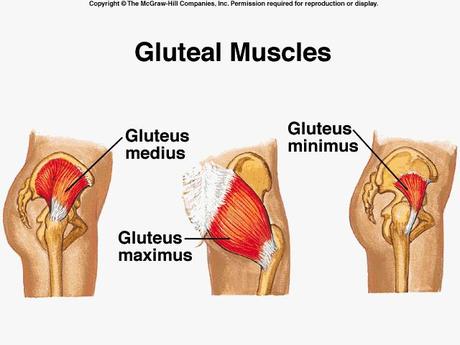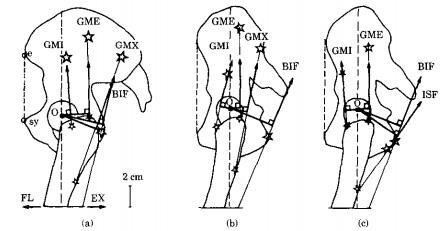This is the fifth article in my series responding to Answers in Genesis critique of my post claiming that their creation museum wrongly portrays the famous Australopithecus afarensis specimen “Lucy” (AL 288-1) as a knuckle-walker. Posts 1, 2, 3 & 4 can be found by clicking on those links. I can’t really think of anything innovative to say in this introduction (you try re-writing the same basic premise 5 times) so lets dive right into it: does the hip indicate Lucy was bipedal?
First, some background. The gluteal muscles are the set of 4 muscles (the gluteus maxmimus, minimus and minimus along with the tensor fasciae latae, which I always remember as a uptight facist with some coffee) which make up your arse. They originate from the rear of the pelvis – including the iliac blade – and travel down onto the leg. Thus when they contract they move the leg relative to the hip (or vice versa), allowing you rotate your legs, lift them sideways and much more. In particular they help keep you stable whilst you walk, ensuring your pelvis is does not topple sideways whilst one leg is in the air.

The gluteal muscles, courtesy of the excellent McGraw Hill
Since these muscles [partly] originate on iliac blade, the size, shape and orientation of this bone will naturally influence how well they work. There was a video which accompanied Answers in Genesis’ original piece on their reconstruction of Lucy in which someone claimed that the angle of Lucy’s iliac blades would’ve hampered the efficiency of the gluteal muscles, in turn preventing them from walking bipedally. Alas I failed to make a note of where one could find this video and it – along with their original article showing off the Lucy exhibit – appears to have disappeared from the site. But don’t worry, I’m not offering you a strawman of their argument. Their critique of my original post advances the exact same claim
The orientation of the iliac blades on the pelvis is a key skeletal requirement for bipedality. Notice this in the photograph of our holographic representation of Lucy and compare to those of a chimpanzee, a gorilla, and a human. The orientation of the iliac wings on the human pelvis allows the human to use gluteal muscles to counterbalance the lifting of the opposite leg during bipedal walking. This stabilizes our hips and keeps us from falling over sideways with each step. The differing orientation of ape iliac bones prevents this use of the gluteal muscles and forces apes to shift and sway from side to side when they occasionally walk upright, rendering an efficient bipedal gait skeletally impossible.
My counterpoint to this argument was that people have performed reconstructions of Lucy’s musculature which reveals that the gluteal muscles were in fact functional and active during bipedal locomotion. Whilst the various skeletal differences between humans and Lucy required her gluteals to expend more energy keeping us stable they did not “prevent” them from doing so as AiG claims. This lowering of efficiency meant that Lucy would’ve had to have used 3.8 joules of energy per kilogram moved per second to walk bipedally – compared to the 3.0 joules humans use – not that she was incapable of bipedalism. For contrast, children aged 8/9 also have to use 3.8 joules and they’re perfectly capable of walking upright.
Answers in Genesis rebuttal to this argument is, as you’ve seen above, to simply reiterate their original claim. They offer no justification for why we should dismiss the science showing the gluteal muscles are functioning, nor do they offer any evidence for why we should accept their position that they do not (beyond the superficial “look at the ape pelvis!”). As such I was half tempted to simply repeat my original argument and leave it at that. After all, they clearly couldn’t fault it.
However, I needed to pad out my word count and decided to examine the closest they came to advancing an argument for their position (beyond the superficial “look at the ape pelvis!”). They cited a 1994 reconstruction of Lucy’s pelvis by Christine Berge which presented two hypotheses for location and orientation of the gluteal muscles of Lucy. The first suggests that they were much like an apes’; the second that they were like a humans’. Whilst the research could not conclude either was fully correct – instead suggesting that the muscle layout was likely “intermediary”, a fact AiG don’t mention – it does suggest that the gluteals were a lot closer to the ape position and so couldn’t have stabilised the hips properly, hampering their bipedal ability and lending support for AiG’s position. Or at least partial support; the research does not conclude they were incapable of walking bipedally habitually but rather were forced to walk with a different gait.

The 1994 reconstruction showing the muscles in a human (left), Lucy if she had human muscles (midlde) and Lucy if she had ape muscles. GMX is gluteus maximus, GME is gluteus medius and GMI is gluteus medius
Unfortunately for AiG this reconstruction suffered from a fundamental flaw: the gluteal muscle markings on Lucy are faint and hard to define so there is no way to identify the correct muscle position. Whilst Berge tried to be as scientific as possible it is naturally quite hard to be rigorousgiven this lack of data. As such her reconstruction is far from definitive. Fortunately another hip bone (STW 431) does contain more substantive gluteal muscle markings allowing for scientists to identify where the muscles are actually located. This hip shows that the gluteal muscles were located in human like positions and thus provides “favourable lever areas for the mm. gluteus medius et minimus for lateral stabilisation of the pelvis in bipedal walking.“

The STW 431 with the muscle attachment sites labelled
Whilst this might seem to destroy the only piece of evidence supporting AiGs claim we must remember STW 431 does not come from the same species as Lucy but rather Australopithecus africanus. Whilst they are close relatives there are still some anatomical differences between Au. africanus and Au. afarensis (Lucy). However, now knowing where these gluteal muscles should be located a researcher was able to re-examine Lucy’s hip and found there was evidence that they were in the same position as in STW 431, effectively refuting Berge’s reconstruction and AiG’s case. Combine this positive anatomical evidence for bipedal-capable musculature with the aforementioned reconstructions of Lucy’s pelvis showing she could walk bipedally and I think I’m justified in saying I was right the first time.

